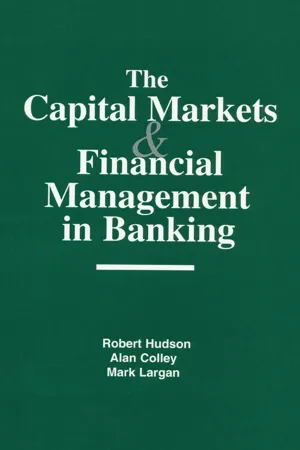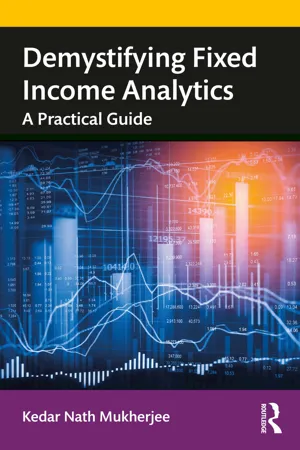Economics
International Bond Market
The international bond market refers to the marketplace where bonds issued by governments, corporations, and other entities are bought and sold across national borders. It provides a platform for investors to diversify their portfolios and for issuers to raise capital from a global pool of investors. The market is influenced by factors such as interest rates, exchange rates, and geopolitical events.
Written by Perlego with AI-assistance
Related key terms
Related key terms
1 of 4
Related key terms
1 of 3
10 Key excerpts on "International Bond Market"
- eBook - ePub
- Todd A. Knoop(Author)
- 2019(Publication Date)
- Greenwood(Publisher)
bond markets, it is important to keep in mind that they really constitute an international market. While the U.S. bond market is primarily comprised of the bonds of the U.S. government and U.S. corporations, people from all over the world can purchase these securities. Over the last thirty years, there has been incredible growth in the pool of foreign savings flowing into U.S. bond markets, particularly from rapidly emerging economies such as China, with rising incomes and high savings rates. Likewise, the increasing importance of multinational corporations that have no centralized business location means that many international companies want to borrow U.S. dollars in the U.S. bond market but also euros in European bond markets and yen in Japanese bond markets. They can do this in the domestic bond markets that exist in each of these places. So, while the focus here is on the U.S. bond market, it is important to keep in mind that our domestic bond market is populated with buyers and sellers from across the world. In domestic bond markets, bonds are bought and sold in the domestic currency. In U.S. bond markets, bonds are denominated in dollars, and if a German company wanted to raise dollars in U.S. bond markets, it would be engaging in issuing foreign bonds denominated in dollars. Increasingly, though, some firms look to issue bonds and raise money in bond markets but not in the local currency. A bond that is denominated in a currency that is not the domestic country’s is referred to as a Eurobond. Calling these bonds Eurobonds is really a misnomer—they do not have to be issued in Europe to be Eurobonds. A bond issued in Japan but denominated in U.S. dollars—regardless of the company or government that issues it—is still a Eurobond. Today, over 80 percent of all bonds issued worldwide are Eurobonds, and this number is growing rapidly. In fact, the international Eurobond market is now larger than the U.S. corporate bond market - Robert Hudson, Alan Colley, Mark Largan(Authors)
- 2013(Publication Date)
- Routledge(Publisher)
11 Eurobonds and International Capital Debt Markets
A bond is a debt instrument issued in bearer or registered form. It constitutes a commitment by the issuer:- to pay a specified sum or sums of money to the holder at a predetermined date or dates;
- to pay interest to the holder at stated intervals either at a fixed rate agreed at the outset or on a floating rate basis often at a margin over a given benchmark, i.e. Libor or an agreed index, e.g. the FTSE index or gold.
The international debt markets are often thought of in terms of eurobonds only. Whilst the eurobond sector is the most visible, it is only one of the methods of capital finance and only one of the options for investors and there are many active domestic markets. Banks regularly access these markets to raise capital and are also active in them as lead managers, advisers, traders, market makers and investors.Domestic debt issues
A domestic debt issue is one that an issuer raises within its own country and is denominated in its own country’s currency. For example, an American company raising U.S. dollars in New York is a totally domestic issue. Domestic issues invariably have a greater attraction to investors resident in the country of issue than investors from elsewhere since most domestic securities are subject to withholding tax. Foreign investors may not be willing or able to take advantage of double taxation agreements which may exist between their own and the issuer’s country, for example, because of the delay in reimbursement of the amount withheld. Domestic issues, therefore, are usually placed mainly with investors of the issuer’s country.The largest and most developed domestic market is in the United States. It is expected that the European bond markets will expand considerably following EMU and in time may equal the U.S. markets in terms of size, trading volume, liquidity and innovation. Investors will have a far bigger domestic market, whereas before they were likely to be restricted to their own national market. A shift is taking place in these markets from government to corporate issues, which mirrors the U.S. markets.- eBook - ePub
The Economist Guide To Financial Markets 7th Edition
Why they exist and how they work
- Marc Levinson(Author)
- 2018(Publication Date)
- Economist Books(Publisher)
4
Bond markets
THE WORD “BOND” means contract, agreement, or guarantee. All these terms are applicable to the securities known as bonds. An investor who purchases a bond is lending money to the issuer, and the bond represents the issuer’s contractual promise to pay interest and repay principal according to specified terms. A short-term bond is often called a note.Bonds were a natural outgrowth of the loans that early bankers provided to finance wars starting in the Middle Ages. As governments’ financial appetites grew, bankers found it increasingly difficult to come up with as much money as their clients wanted to borrow. Bonds offered a way for governments to borrow from many individuals rather than just a handful of bankers, and they made it easier for lenders to reduce their risks by selling the bonds to others if they thought the borrower might not repay. The earliest known bond was issued by the Bank of Venice in 1157, to fund a war with Constantinople.Today, bonds are the most widely used of all financial instruments. The size of the global bond market in 2017 was approximately $95 trillion, of which roughly $72 trillion traded on domestic markets, and another $23 trillion traded outside the issuer’s country of residence.In the United States, the largest single market, nearly $800 billion worth of bonds changed hands on an average day in 2017, and the value of outstanding bonds at the end of 2017 exceeded $40 trillion. Table 4.1 shows the countries with the largest domestic debt markets.Bond issuance grew rapidly in many countries from 2009 to 2012, for a variety of reasons. Poor economic conditions encouraged many governments to run large budget deficits, funded by the sale of government bonds, in order to stimulate their economies. Extremely low long-term interest rates made it attractive for many companies to issue bonds even if they had no immediate need for the money. The improved economic health of some major countries, notably China, Brazil and Mexico, enabled companies in those countries to borrow far more cheaply than in the past in both domestic and foreign currency, contributing to an emerging-market bond boom that ended in 2013. China, where domestic bond issuance was minor in the early 2000s, now has the world’s third-largest domestic bond market. - David P. Stowell(Author)
- 2012(Publication Date)
- Academic Press(Publisher)
Although London is the unofficial center of the Euromarkets, Frankfurt and Paris are large centers as well. One reason European cities tend to dominate this market is due to their geographic convenience to markets in the Americas and Asia. Euromarkets can also be considered to include certain Caribbean countries such as the Cayman Islands, which have significant foreign deposits as well. The Euromarkets are attractive because they are, for the most part, unregulated and sometimes offer higher yields to investors. This market has become a significant source of global liquidity.Eurobonds are debt instruments that are listed on an exchange in bearer form (i.e., owned by whoever is holding the security instead of in registered form with registered owners). They are issued and traded outside the country whose currency the Eurobond is denominated in, and outside the regulations of a single country. Interest income from these bonds is exempt from withholding tax and the bonds are generally not registered with any regulatory body. For example, while a U.S. corporation’s domestic bonds are subject to SEC oversight, its Eurobonds are not (unless offered concurrently to U.S. investors). The market is self-regulated through the International Capital Markets Association (ICMA). Eurobonds are generally issued by multinational corporations or sovereign entities of high credit quality. An international syndicate of banks typically underwrites a Eurobond issuance and distributes the bonds to investors in a number of countries (other than the country of the issuer).Eurobonds can be issued in many forms, including fixed-rate coupon bonds (interest is usually payable annually and principal is due in bullet form), convertible bonds, zero-coupon bonds, and floating rate notes. Eurobonds issued in U.S. dollars are called Eurodollar bonds; Eurobonds issued in Japanese yen are called Euroyen bonds. There are many other currencies in which Eurobonds are issued, including pound sterling, euro, and Canadian dollar, among others. In each case, the Eurobond is named after the currency in which it is denominated. Almost all Eurobonds are owned “electronically” rather than in physical form and are settled through either Euroclear or Clearstream, two global electronic depositary systems.- eBook - ePub
An Introduction to International Capital Markets
Products, Strategies, Participants
- Andrew M. Chisholm(Author)
- 2009(Publication Date)
- Wiley(Publisher)
4 Major Government Bond Markets4.1 CHAPTER OVERVIEW
This chapter explores the market for major government bonds, in particular those issued by G7 countries such as the US, the UK, Japan, and countries in the eurozone. It considers issuance procedures and trading methods in the secondary markets. The most active government bond market is the market for US government debt, and many of the conventions used there have been exported around the world. For example, UK government bonds (gilts) and government bonds issued in the eurozone now use the day-counting convention developed in the US market. The chapter looks at how bonds are quoted and valued using discounted cash flow techniques. Two measures of bond yield or return are introduced: current or running yield, and yield-to-maturity. Finally, investors in government bonds cannot ignore the possibility that governments may default on debt obligations, or at least seek to reschedule payments. The risk of default is very low in the case of US debt but can be substantial with bonds issued by developing countries. The chapter explores sovereign risk and the credit rating of sovereign debt by the major agencies.4.2 INTRODUCTION TO GOVERNMENT BONDS
Bonds are long-term negotiable debt securities issued by governments, government agencies, financial institutions, and corporations to raise debt capital. The majority are straight or ‘plain vanilla’ bonds which:• pay fixed interest amounts - known as coupons - on regular dates;• have a fixed maturity or redemption date, at which point the bond’s par or face value is repaid to the investor.Governments around the world raise long-term debt by issuing bonds to finance budget deficits, the difference between government spending and the money raised by taxation. On the other hand if a government runs a budget surplus - eBook - ePub
Demystifying Fixed Income Analytics
A Practical Guide
- Kedar Nath Mukherjee(Author)
- 2020(Publication Date)
- Routledge India(Publisher)
1 Fixed income securities are issued by various organizations, i.e. central and state governments, public bodies, statutory corporations, banks, financial institutions, and corporate bodies. These markets are an important source of funds, especially in developing economies like India. In order to finance its fiscal deficit, the government (central and state) borrows money from the market by issuing government securities (G-Secs.), which are sovereign securities issued by, say, the central bank of the country (e.g. Reserve Bank of India or RBI) on behalf of the government. The role of fixed income markets as an efficient tool to raise money for government projects (national and local) has been considered and appreciated worldwide for centuries.Global debt markets — a reviewThe financial market of an economy gets the status of developed market if it is characterized by proper financial, legal, and regulatory frameworks. Even if the equity markets of the financial system in most of the world economies, including India, are well developed, the same may not be valid in case of the bond market, especially the market for non-government securities. The following section deals with a broader overview of the debt market (government and non-government) in some of the developed and emerging, especially Asian, economies which have experienced a significant growth over the years in developing their debt (government and corporate) market.US debt marketThe bond market in the United States is the largest market in the world, with a total outstanding of USD 37.0 trillion at the end of 2017. The proportion of debt securities in the US securities market is almost equal to that of equities, reflecting an equal importance of their debt market (162% and 198% respectively for equities and debts as a percentage share of US GDP during the end of 2017) comparative to other economies, where concentration of equities is more than the debts. The corporate bond market in United States is again the largest market (22% of the total bond issuance in US) in the world, not only in terms of outstanding volume (USD 9 trillion during the end of 2017), but also in terms of annual turnover in the secondary market. The US debt market is a very well-developed and efficient market with a high level of liquidity in the secondary markets (USD 764 billion of daily trading volume, of which USD 505 billion was in Treasury securities during 2017). The reason for this being that the interest of not only the corporate but also the banks and other institutions tapping the debt market, rather than seeking loans or deposits to meet their financial requirements (10% of loan financing vs. almost of 70% of financing through capital markets). The US bond market is also well diversified and consists of several instruments, such as Treasury bills and bonds, federal agency securities, municipal bonds, corporate bonds, mortgage backed securities (MBS), asset backed securities (ABS), etc. In order to strengthen the demand for corporate bonds, a developed market like the US has experienced a significant demand from financial institutions like banks, mutual funds, insurance companies and pension funds. The US corporate bond market has experienced a wider investor base that also includes retail investors. Mortgage-related debt captures the maximum market share (annual average: 26–27%), followed by the Treasury issues and corporate debts, respectively, with an annual average of close to 24 and 20%. Domestic and foreign investors play a dominant role in the world’s largest debt market. The annual average participation of FIIs in the US Treasury market is almost 38.50% out of total outstanding Treasury debts. But in terms of average daily trading volume in US debt market, the Treasury market captures more than 60% of the secondary market trading, followed by the MBS (28%), and others. The development and growth in the US debt securities market are presented in the following tables (Table 1.1 to 1.3 - John Lipsky, Peter Keller, Donald Mathieson, and Richard Williams(Authors)
- 1983(Publication Date)
- INTERNATIONAL MONETARY FUND(Publisher)
IV International Bond Markets
Passage contains an image
Introduction
Since the fourth quarter of 1981, international markets have witnessed historically high rates of bond issuance. During 1982, total international bond issues rose by 50 percent, with Eurocurrency bond issues increasing by over 75 percent and foreign bond issues by 18 percent.35 Investor demand for new issues was stimulated by the prospect of declining long-term interest rates, the reappearance of a positively sloped yield curve, and the continuance of high ex post real yields, especially on longer-term bonds. The supply of new issues was generated by the financing needs of the fiscal authorities in many of the industrial countries, the desire of private corporations to secure longer-term sources of finance, and the borrowing programs of the various multinational institutions. Most of the borrowers and lenders in the International Bond Markets were from the industrial countries, and the non-oil developing countries were generally absent from the bond markets, especially during the second half of 1982 and the first quarter of 1983.The U.S. dollar continued to serve as the primary currency of denomination. Bond maturities did not change significantly in most markets; where some change was observed, however, it mainly took the form of a movement away from both short-term and long-term bonds into medium-term instruments. A number of new bond market instruments and new funding techniques appeared. Examples were interest rate swaps that involved the exchange between borrowers of fixed rate debt for floating rate debt, extendable bonds that offered the option of changing the maturity of the bond, and partially paid and deferred payment bonds. The latter appealed to investors expecting declines in nominal interest rates. These new instruments, along with the continued utilization of the traditional straight debt instruments, were all designed to further increase the attractiveness of longer-term bonds for investors and to give borrowers access to various national bond markets.- eBook - ePub
Governments, Banks and Global Capital
Securities Markets in Global Politics
- Miroslava Filipovi?(Author)
- 2018(Publication Date)
- Routledge(Publisher)
52In addition, it has to be stressed that supranational (international governmental) issuers have maintained their share in the global market. In 1990, the two most active borrowers were the World Bank and the European Investment Bank. That stands in sharp contrast to a radical decline on the part of sovereign and corporate issuers.53 A particular example of the growing level of worldwide integration of securities markets is the successful 1989 issue of the first global bond by the World Bank. This was among the first attempts to issue a bond which would simultaneously tap the Eurobond and Yankee bond markets. Although significant liberalization measures in relation to capital controls had been pursued, the global market remained segmented due to divergent market traditions:The World Bank global bond represented an experiment to see if these practices could be reconciled and the differences overcome, thus allowing the borrower simultaneous access to a large pool of investors and, by creating a much more liquid instrument, reducing its borrowing costs.54Another aspect of the increasing level of global market integration is the rising importance of the so-called "emerging markets", basically those in Latin America and South-East Asia. According to the International Finance Corporation, emerging markets are those not yet fully developed in the organizational and institutional sense. Emerging markets usually display significant price volatility and a high degree of market concentration (e.g. the share of market capitalization held by the ten largest stocks). They also feature varying degrees of openness and lower standards in respect of disclosure, market transparency and investor protection. - eBook - ePub
Investing in Fixed Income Securities
Understanding the Bond Market
- Gary Strumeyer(Author)
- 2012(Publication Date)
- Wiley(Publisher)
Chapter 5 Macroeconomics and the Bond Market It is imperative that investors understand the workings of the economy prior to investing in fixed income securities. Economic analysis falls into two general categories. Macroeconomics is the discipline that deals with the overall economy. Unemployment, inflation, the budget deficit, and foreign trade are among the issues the investor needs to become familiar with as an integral part of his investment plan. Microeconomics deals with narrower issues such as how, what, and at what price products are produced. Concepts such as supply and demand and elasticity of demand fall under this latter discipline, and while these concepts are both valuable and intriguing, they are not as relevant to the fixed income markets. Therefore this chapter will deal solely with the macroeconomic concepts that influence the bond markets. For those of you well versed in economic theory, feel free to skip ahead to the “Bond Yields and the Macroeconomy” section of this chapter. ECONOMICS 101 Just as cyclical changes in the economy influence the performance of equities, so too will these changes affect fixed income securities. This effect manifests itself in two ways: 1. Credit risk. A poorly performing national economy can affect the economic well-being of states and their political subdivisions, as well as corporations. These changes will result in price movements of both municipal and corporate bonds. In the same way, a poorly performing foreign economy will affect the value of international fixed income securities. 2. Interest rate risk. A change in the overall level of interest rates will have a profound effect on overall bond prices. Understanding the economic variables associated with interest rate movements is critical in effectively managing one’s fixed income portfolio - Maxwell Watson, Peter Keller, and Donald Mathieson(Authors)
- 1984(Publication Date)
- INTERNATIONAL MONETARY FUND(Publisher)
IV Developments in International Bond Markets and Other Capital Flows
Passage contains an image
Developments in International Bond Markets
Overview
Since 1981, issues of international bonds43 have risen in absolute terms and even more sharply relative to the declining volume of international syndicated loans. Following large increases in 1981 and 1982, international bond issues rose only slightly in 1983 to $77 billion, of which $48 billion represented net new issues (Table 9 ).44 In 1983, Eurobond issues remained at their 1982 value of $50 billion, and foreign bond sales rose from $25 billion to $27 billion. In contrast to the sharp decline in nominal interest rates experienced in 1982, most financial markets witnessed relatively limited changes in interest rates (especially for long-term maturities) between December 1982 and December 1983, although the average level of rates in 1983 was lower than in the preceding year. Declining rates of inflation in many financial market countries, however, implied the continuation of high ex post real returns on bonds. The vast majority of international bonds were issued and purchased by entities in the industrial countries. Developing countries as a group continued to have only very limited access to these markets. The relative importance of different types of bonds has been strongly affected by the rapid expansion in the issuance of floating rate notes.Interest Rate Developments
Charts 4 and 5 and Table 37 show interest rate movements in the major financial markets during 1983. Between December 1982 and December 1983, short-term interest rate movements were relatively limited; in most cases, rates fluctuated within a 1 percentage point band throughout the year. These developments in conjunction with declining inflation sustained high ex post real interest rates (Table 36
Index pages curate the most relevant extracts from our library of academic textbooks. They’ve been created using an in-house natural language model (NLM), each adding context and meaning to key research topics.
Explore more topic indexes
Explore more topic indexes
1 of 6
Explore more topic indexes
1 of 4









